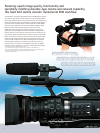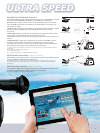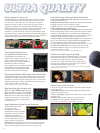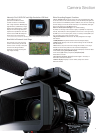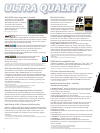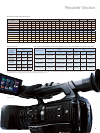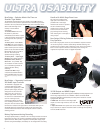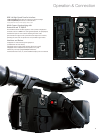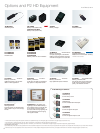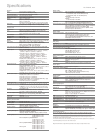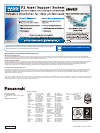
ULTRA QUALITY
AVC-ULTRA Codec Supported as Standard
The AJ-PX270 is the first handheld
camera recorder that features the
AVC-ULTRA codec family as standard.
To meet the various needs from
mastering to streaming, the image
quality and bit rate can be selected to
match the application.
(See the table on the next page.)
AVC-Intra using intra-frame compression method
which is highly suited to image production. In addition to the conventional
AVC-Intra100/50, AVC-Intra200 codec will be available as option.*
1
Visually
lossless images quality and superb 24 bit audio, it offers a level of quality
that meets the needs of mastering or archiving.
This inter-frame compression method achieves high-
quality HD recording at a low bit rate. Ideal for providing on-air content
direct from the shooting location and for workflows using content
transferred over the internet. Three bit rates are available:
AVC-LongG50/25/12 Mbps. AVC-LongG25 provide 10 bit/4:2:2 quality at a
bit rate of approximately 25 Mbps.
Low-bit-rate, high-resolution, high-sound
quality proxy video (Quick Time/H.264) can be recorded
simultaneously with main video.*
1
Also includes metadata for
efficient offline editing.
*1: Available in the near future. Proxy data cannot be recorded when using the Loop Rec or Interval Rec
function. Proxy data is low-resolution video and audio data with time code, metadata, and other
management data in a file format. The use of DCF Technologies is under license from Multi-Format, Inc.
Dual Codec Recording for Smooth Network Connection*
2
The AJ-PX270 can record the main video data (MXF format) with an
AVC-Intra100/50 or AVC-LongG50/25 codec, while simultaneously
recording proxy video data at a low bit rate. Using the network function,
it is capable of IP transmission of proxy video data via LAN, wireless LAN*
3
or 4G/3G network.*
4
This enables news flash distribution and advance
editing before the main video data arrives, dramatically speeding up the
video production workflow.
*2:
Some formats are not supported depending on the recording mode. For details, visit Panasonic website
(http://pro-av.panasonic.net/).
*3: For a wireless LAN connection, the AJ-WM30 Wireless Module is required.
*4: Available in the near future. 4G/3G module is required.
The use of DCF Technologies is under license from Multi-Format, Inc.
Metadata Function Supporting Wireless Connection
The metadata function attaches metadata (text memos tagged to time,
GPS data, selected character strings and frames) to P2 files. Metadata can
be edited using a tablet or smartphone connected via USB or wireless
LAN.*
5
Metadata can be used effectively for searching and management,
facilitating the editing, distribution and archiving of video data.
*5: For a wireless LAN connection, the AJ-WM30 Wireless Module is required.
High-Quality 24 Bit 4 Channel Audio Recording
AVC-Intra and AVC-LongG*
6
modes support 24 bit digital audio recording*
7
(16 bit for DVCPRO HD, DVCPRO 50, DVCPRO and DV). The AJ-PX270 offers
4 channel audio in all recording modes. Channel input locates in front
and rear (both selectable from mic/line). The level volume also supports
4 channels.
*6: The AVC-LongG12 mode does not support 24 bit digital audio recording.
*7: The audio signal can be played back by using 24 bit digital audio equipment. For details, refer to "Note
Regarding 24 bit Audio" on page 9.
MicroP2 Card Slots
The AJ-PX270 comes with two slots for the
microP2 card, the broadcast-use memory
card downsized to match the size of a
conventional SD memory card.
• microP2 card: While inheriting the high
reliability of the P2 card and maintaining
the large capacity of 64 GB,*
8
the microP2
card was greatly downsized to match the
size of an SD Memory Card, resulting in a considerable reduction in cost.
One P2 card slot is also provided for the use of a conventional P2 card.*
9
• Content Protection System (CPS): A new security function featured on
the microP2 card. The content recorded on the card is locked with a
password to protect against unauthorized access. This prevents data from
being stolen and enables secure media control.
• Highly Mobile and Reliable: The microP2 and P2 cards are highly
resistant to temperature changes, dust, impacts, and vibration, and there
are no worries about condensation, head clogging, or dropout as there are
with VTR systems. Data is recorded onto empty card spaces, so there is no
need to search for the beginning and ending of recorded portions. There is
also no danger of mistakenly recording over existing data.
*8: Total card capacity includes space for data management, such as system data; therefore, the actual
usable area is less than the capacity indicated on the card. See the "Recording Times" table on Page 6 for
recording times.
*9: microP2 and P2 cards cannot be simultaneously recorded on.
HD/SD Multi Format/Multi Codec
In addition to 1080/60i,*
10
the AJ-PX270 supports 24p,*
10
30p,*
10
60p,*
10
and
720p multi HD format and SD recording. 59.94 Hz/50 Hz switchable for
convenient use in productions headed for global use.
*10: 60i, 60p, 24p, and 30p are actually recorded at 59.94 Hz, 23.98 Hz, and 29.97 Hz respectively.
Full Frame Progressive Recording
1080/60p*
11
(50p) full frame progressive recording is supported for the first
time in the AJ-PX270. In addition to being able to record with the
AVC-Intra100 or AVC-LongG25/LongG12 codec, the camera can is capable
of camera through output from the 3G SDI and HDMI output terminals.
*11: 60p is actually recorded at 59.94 Hz.
Multifunctional Recording*
12
Including
Simultaneous Recording
• Simultaneous Rec:*
13
Records simultaneously onto two microP2 cards.
A recording mode that continuously records onto one of the two cards
will be available in the near future.
• Hot-Swap Rec:*
13
Thanks to the two card slots,*
14
you can hot-swap
microP2 cards for continuous non-stop recording.
• One-Clip Rec Mode: Records up to 99 consecutive cuts as a single clip.
A text memo is automatically attached to the Rec Start point for easy
searching for the beginning of the cut.
• Pre Rec: This stores approximately 3 seconds of HD or 7 seconds of SD
video and audio data in memory while in standby mode and lets you
recover and use the data from the point before you started recording.
• Loop Rec: Maintains a recording of a certain time period through
repeated loop recording.
• Interval Rec: Automatically records intermittently based on a set interval
and recording time.
• One-Shot Rec: A frame-shot recording function for producing animations.
• Text Memo:*
15
Up to 100 memos can be posted onto a clip as bookmarks.
• Shot Marker:*
15
Used to mark clips as OK, NG, etc.
• Last Clip Delete: Deletes the last recorded clip with a single touch.
• Rec Check: This lets you run a quick playback check of the clip-end you
have just recorded.
*12: microP2 and P2 cards cannot be simultaneously recorded.
*13: Recording is possible only through the microP2 card slots.
*14: Slots cannot be switched during recording.
*15: The text memo and shot mark cannot be added in Loop Rec, Interval Rec, or One-Shot Rec mode.
AVC-ULTRA Codec LSI
5




